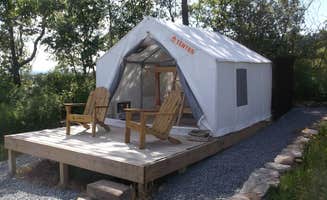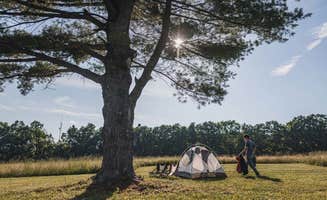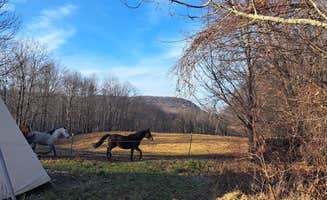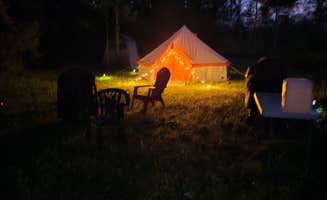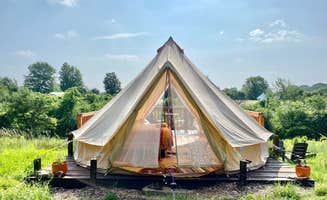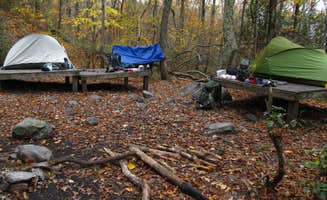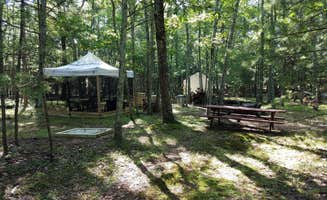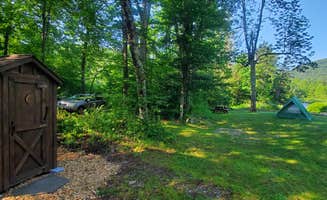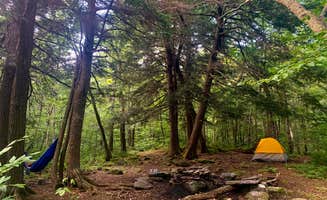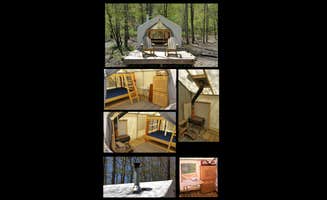Dispersed camping near Slingerlands, New York provides access to the diverse landscapes of the Capital Region and nearby Catskill Mountains. The area sits at elevations ranging from 200-4,000 feet, creating varied camping conditions across seasons. Winter temperatures regularly drop below freezing, while summer nights remain cool even when daytime temperatures reach the 80s, requiring campers to pack appropriate layers year-round.
What to do
Hiking to viewpoints: Giant Ledge Primitive Camp offers challenging but rewarding trails. "There's a couple marked campsites scattered along the trail, we camped at the first one on the way up. Good hike with a bit of a challenge climbing rocks at the end towards the ledge but nothing crazy," notes Emily S. The trail rises steeply, gaining significant elevation.
Fishing opportunities: Several primitive sites provide access to small ponds and lakes. At Echo Lake, campers can fish directly from shore. "We camped on the hill with a beautiful view of the whole lake and breeze," reports James A. Anglers should check New York fishing regulations as a license is required for those 16 and older.
Wildlife observation: The forests surrounding Slingerlands host diverse wildlife including deer, foxes, and various bird species. John S. from Giant Ledge Primitive Camp mentions, "Thought I heard bears come through overnight, but may have been a lucid dream. Bear can was undisturbed in the morning." Proper food storage in bear canisters is essential when camping in these areas.
What campers like
Natural water features: Ponds and streams enhance several tent campsites near Slingerlands, New York. According to Yae U. at Duck Pond Campsite, "The pond is small so the mosquitos were not too bad. So few people passed by and very unknown quite and we just loved the experience." Many campers appreciate the sound of running water near their sites.
Elevated camping spots: Higher terrain sites provide better airflow and views. Kay D. describes Alander Trail Campground: "You have to park at the entrance and hike in about 1.5-2 miles with everything on your back to get to the spots. Once you get there, theres quite a few sites to choose from and each offer quite a bit or privacy."
Established fire pits: Many dispersed sites feature stone fire rings. The L. notes at Ushers Road State Forest, "This leads to a previously used campsite, approximately 200 feet from the main trail. The site includes a stone fire ring, indicating prior use." Fire regulations vary by location and season, so check current restrictions before planning to have a campfire.
What you should know
Access road conditions: Many tent camping areas require navigation on unpaved roads. The L. warns about Duck Pond Campsite, "The road in on old cemetery rd was pretty rough, so we decided to go out the other way, which was way worse... Intermittent cell service which was frightening while driving on these rough roads." High-clearance vehicles are recommended for many locations.
Trail difficulty: Some camping areas require significant hiking. Caleb J. explains about Giant Ledge: "It is a near vertical hike the first mile with 90% or more being over rock gardens. Not some rocks littering the trail. I think the trail used to be a stream or creek. It doesn't wind it's way up the mountain, someone picked a side and said 'we go up from here, straight up'."
Water sources: Most dispersed sites lack potable water. John S. notes at Giant Ledge, "The spring water source is a short hike back from the campsite, relatively convenient to restock from camp." Water filtration systems are necessary at all primitive campsites in the region.
Tips for camping with families
Choose accessible sites: Families with young children should select locations with shorter hiking distances. Annmarie J. describes Alander Trail Campground as "a beautiful campground that is about a mile hike from the trailhead." This distance is manageable for most school-age children carrying light packs.
Pack entertainment: Natural features provide built-in activities. Kate at Echo Lake suggests, "Note, it can get swampy near the edge of the lake so you may want to bring bug spray. Make sure you practice leave no trace principles and pack out what you bring in!" Children enjoy exploring shorelines and identifying wildlife.
Plan for temperature variations: Mountain elevations experience significant day-to-night temperature swings. HOGAN'S LANDING provides access to lower elevation camping with more moderate temperature variations, making it better suited for families with very young children who may struggle with cold nights.
Tips from RVers
Size limitations: Most dispersed camping areas cannot accommodate large recreational vehicles. The L. at Ushers Road State Forest notes that the "trailhead provides access to bicycle-friendly nature trails" but the actual camping areas require walking into the woods, making them unsuitable for RVs larger than campervans.
Alternative established campgrounds: For those requiring hookups, traditional campgrounds offer better options. Ashley F. recommends, "Each site has a private bathroom and hot shower, as well as a kitchenette" at Getaway Catskill Campground, making it suitable for those wanting amenities not available at dispersed sites.
Parking considerations: Even when tent camping from an RV base, parking can be challenging. Liz P. found Alander Trail Campground's parking area sufficient but notes, "Although we were the only campers at the time the area was emmaculate and not one piece of trash on the ground anywhere!" Limited parking fills quickly during peak season weekends.


